Wednesday, April 6, 2011
Shamo Breed
Ko Shamo
Background information: The Japanese are masters in minimizing objects and living things (bonsai trees, chicken, fish) The geographical conditions in Japan gave birth to this extra ordinary skill. There is almost no space to build as Japan is for 75% a country with hills and mountains. To enable indoor keeping of gamefowl they have created the Ko Shamo, a small game breed still in possession of a game character. A trio of these birds are kept on a space of 4 square feet. Despite these conditions fertility is excellent same as their laying performance and hatch rate. Growing up the chicks goes without problems, however a too overcrowded surface leads to a bloody war in the sense of the word as they display their "killer" instinct in an early live stage. Ko Shamo are very popular in Japan and Europe due to their qualities. They have following features: strawberry or walnut comb, pearlish eyes, extremely short in feathers, wings carried from the body the wing joints pointing above the shoulders.The tail is known as "shrimp" tail (main sickle feathers curving down, side feathers pointing in horizontal direction). Also a very typical feature is the socalled open or split wing which in Japan is seen at the best birds. The whole body is divided in 3 equal parts (length) 1) head and neck, 2) body, 3) legs. Weight: male 2 Lbs (0.9 Kg), female 1.8 Lbs (0.8 Kg). Height: 9.8" (± 25 Cm). Another typical feature is that Ko Shamo walk on their front toes. Dispite the fact that Ko Shamo's succesfuly can be kept and bred under less fortunate conditions it is advised to give these birds sufficient space. Ko Shamo's are bred in a wide variety of colours. Its an ideal bird for the less fortunate (concerning living space) fancier of Asian gamefowl.
The Japanese are masters in minimizing objects and living things (bonsai trees, chicken, fish) The geographical conditions in Japan gave birth to this extra ordinary skill. There is almost no space to build as Japan is for 75% a country with hills and mountains. To enable indoor keeping of gamefowl they have created the Ko Shamo, a small game breed still in possession of a game character. A trio of these birds are kept on a space of 4 square feet. Despite these conditions fertility is excellent same as their laying performance and hatch rate. Growing up the chicks goes without problems, however a too overcrowded surface leads to a bloody war in the sense of the word as they display their "killer" instinct in an early live stage. Ko Shamo are very popular in Japan and Europe due to their qualities. They have following features: strawberry or walnut comb, pearlish eyes, extremely short in feathers, wings carried from the body the wing joints pointing above the shoulders.The tail is known as "shrimp" tail (main sickle feathers curving down, side feathers pointing in horizontal direction). Also a very typical feature is the socalled open or split wing which in Japan is seen at the best birds. The whole body is divided in 3 equal parts (length) 1) head and neck, 2) body, 3) legs. Weight: male 2 Lbs (0.9 Kg), female 1.8 Lbs (0.8 Kg). Height: 9.8" (± 25 Cm). Another typical feature is that Ko Shamo walk on their front toes. Dispite the fact that Ko Shamo's succesfuly can be kept and bred under less fortunate conditions it is advised to give these birds sufficient space. Ko Shamo's are bred in a wide variety of colours. Its an ideal bird for the less fortunate (concerning living space) fancier of Asian gamefowl.
 The Japanese are masters in minimizing objects and living things (bonsai trees, chicken, fish) The geographical conditions in Japan gave birth to this extra ordinary skill. There is almost no space to build as Japan is for 75% a country with hills and mountains. To enable indoor keeping of gamefowl they have created the Ko Shamo, a small game breed still in possession of a game character. A trio of these birds are kept on a space of 4 square feet. Despite these conditions fertility is excellent same as their laying performance and hatch rate. Growing up the chicks goes without problems, however a too overcrowded surface leads to a bloody war in the sense of the word as they display their "killer" instinct in an early live stage. Ko Shamo are very popular in Japan and Europe due to their qualities. They have following features: strawberry or walnut comb, pearlish eyes, extremely short in feathers, wings carried from the body the wing joints pointing above the shoulders.The tail is known as "shrimp" tail (main sickle feathers curving down, side feathers pointing in horizontal direction). Also a very typical feature is the socalled open or split wing which in Japan is seen at the best birds. The whole body is divided in 3 equal parts (length) 1) head and neck, 2) body, 3) legs. Weight: male 2 Lbs (0.9 Kg), female 1.8 Lbs (0.8 Kg). Height: 9.8" (± 25 Cm). Another typical feature is that Ko Shamo walk on their front toes. Dispite the fact that Ko Shamo's succesfuly can be kept and bred under less fortunate conditions it is advised to give these birds sufficient space. Ko Shamo's are bred in a wide variety of colours. Its an ideal bird for the less fortunate (concerning living space) fancier of Asian gamefowl.
The Japanese are masters in minimizing objects and living things (bonsai trees, chicken, fish) The geographical conditions in Japan gave birth to this extra ordinary skill. There is almost no space to build as Japan is for 75% a country with hills and mountains. To enable indoor keeping of gamefowl they have created the Ko Shamo, a small game breed still in possession of a game character. A trio of these birds are kept on a space of 4 square feet. Despite these conditions fertility is excellent same as their laying performance and hatch rate. Growing up the chicks goes without problems, however a too overcrowded surface leads to a bloody war in the sense of the word as they display their "killer" instinct in an early live stage. Ko Shamo are very popular in Japan and Europe due to their qualities. They have following features: strawberry or walnut comb, pearlish eyes, extremely short in feathers, wings carried from the body the wing joints pointing above the shoulders.The tail is known as "shrimp" tail (main sickle feathers curving down, side feathers pointing in horizontal direction). Also a very typical feature is the socalled open or split wing which in Japan is seen at the best birds. The whole body is divided in 3 equal parts (length) 1) head and neck, 2) body, 3) legs. Weight: male 2 Lbs (0.9 Kg), female 1.8 Lbs (0.8 Kg). Height: 9.8" (± 25 Cm). Another typical feature is that Ko Shamo walk on their front toes. Dispite the fact that Ko Shamo's succesfuly can be kept and bred under less fortunate conditions it is advised to give these birds sufficient space. Ko Shamo's are bred in a wide variety of colours. Its an ideal bird for the less fortunate (concerning living space) fancier of Asian gamefowl.Source:
Shinichi Zenimoto (Japan)Ikuo Watanabe (President of the Japan Small Shamo Club)
Shinichi Zenimoto (Japan)Ikuo Watanabe (President of the Japan Small Shamo Club)
(www.geocities.com/Tokyo/Shrine/2425/koshamo.htm)
The Ko Shamo is a bantam game breed from Japan.
It is the most numerous of the small Shamo breeds, being popular in all areas of Japan, but it is not a bantam version of the large Shamo. They are strong muscular little birds with very sparse plumage. Their most important attributes should be character and attitude, strong head and beak, upright stance, prominent shoulders, very short hard feather, and tiny prawn� tail (which means a tail like a prawn�s tail, not like a prawn). The weight of an adult male is around 1kg.
Different types are considered to be correct in Japan, so there will always be variation within the breed, some lighter, some chunkier, some with wrinkly faces, some not so wrinkly - but they should all have the typical Ko Shamo attributes, especially the characteristic cheeky, cocky attitude. However, despite the game spirit, this is an ornamental pet and show breed, not designed for fighting.
 There are no fixed plumage colours but, as an ornamental breed, attractive colouration can add to the appeal of a good bird. Normal colouration is: beak yellow or horn; legs and feet yellow, with dusky markings also being acceptable in dark coloured birds; face- red; and eyes silver o
There are no fixed plumage colours but, as an ornamental breed, attractive colouration can add to the appeal of a good bird. Normal colouration is: beak yellow or horn; legs and feet yellow, with dusky markings also being acceptable in dark coloured birds; face- red; and eyes silver o
It is the most numerous of the small Shamo breeds, being popular in all areas of Japan, but it is not a bantam version of the large Shamo. They are strong muscular little birds with very sparse plumage. Their most important attributes should be character and attitude, strong head and beak, upright stance, prominent shoulders, very short hard feather, and tiny prawn� tail (which means a tail like a prawn�s tail, not like a prawn). The weight of an adult male is around 1kg.
Different types are considered to be correct in Japan, so there will always be variation within the breed, some lighter, some chunkier, some with wrinkly faces, some not so wrinkly - but they should all have the typical Ko Shamo attributes, especially the characteristic cheeky, cocky attitude. However, despite the game spirit, this is an ornamental pet and show breed, not designed for fighting.
 There are no fixed plumage colours but, as an ornamental breed, attractive colouration can add to the appeal of a good bird. Normal colouration is: beak yellow or horn; legs and feet yellow, with dusky markings also being acceptable in dark coloured birds; face- red; and eyes silver o
There are no fixed plumage colours but, as an ornamental breed, attractive colouration can add to the appeal of a good bird. Normal colouration is: beak yellow or horn; legs and feet yellow, with dusky markings also being acceptable in dark coloured birds; face- red; and eyes silver o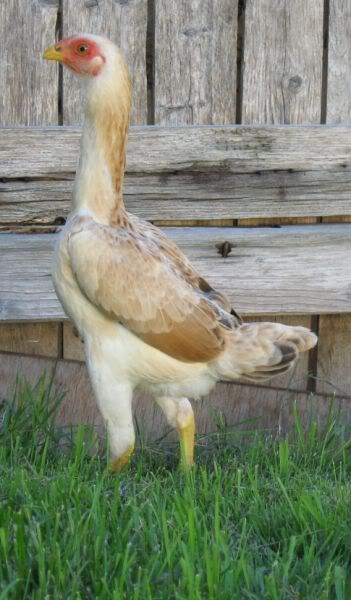
r goThis pullet is out of Micheal Stumme's strain as well. What a pullet she is! Thanks Suzann!
"They are BEAUTIES!!! Definitely the best I have seen in USA. Type-wise they are as good as any in the world. Excellent!" Julia Keelingld.
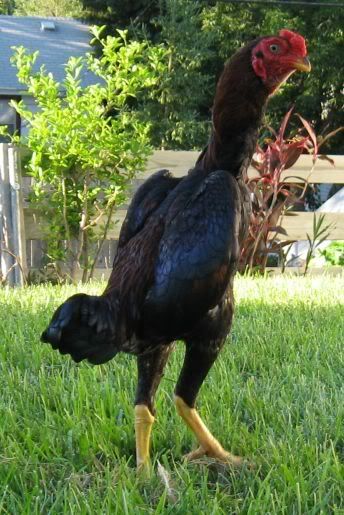
Reza Asil
Information provided by: The International Asil Association (IAA)The International Asil Association (IAA)
The Asil is found on the Indian sub-continent and as mentioned earlier is probably the world oldest gamefowl breed. The oldest evidence of organized cockfighting is based on archeological finds which have been found in the Indus valley (today Pakistan but Indian territory till 1947). Understanding the Asil is not that easy. The breed is domestic to the Indian subcontinent. At present day this landmass consists of the following countries India, Pakistan, Bangladesh and Sri Lanka. This huge landmass is home to an enormous variety of ethnic groups and cultures. Tracing back local names of varieties or expressions is a pure hell as India alone has 21 national languages and over 200 registered dialects. Sometimes information from the homeland is controversial. Therfor analysis and comparison of this information is a delicate matter. Asil enthusiasts from all over the world provide valuable information. The International Asil Association (IAA) tries to provide genuine information enabling all Asil fanciers around the world to preserve the Asil breed along the proper conservation and breeding criteria.
The Reza is a small Asil with a weight not exceeding a weight of about 3 Kg (6.6 Lbs). This group of Asil reached worldwide popularity due to books and articles written by the English gamefowl expert Herbert Atkinson, Siran and Paul Deraniyagala from Sri Lanka and Carlos Finsterbusch from Chile. The Reza Asil family according the old (Western) gamefowl literature is subdivided into following strains: (Amir) Ghan, Sonatol, (Siyah) Rampur, Kalkatiya (Kaptan) and Jawa. All these strains are indentified by their specific color (!) In chronological order: blackreds, lightreds, black, speckled reds and silver duckwings. In the old days (colonial times) other colors such as whites, spangles, etcetra were regarded as -inferior-. According Herbert Atkinson purebred Asil should not exceed the weight of 3 Kg (6.6 Lbs). At present day the "classic" strains and names given mentioned by Atkinson are more or less forgotten. Anyone with a bit of breeding expirience will understand that after many decades the vitality of a bloodline slowly will be prone to degeneration. Remark: the native people in India, Pakistan, Bangladesh and Sri Lanka only know the Reza-type Asil by their local names (see Names paragraph).
__________________________________________________________________________________
This 2007 cock is out of stock in Puerto Rico were the competitive games are legally held . The breeder is Javier Rosario and they were brought into P.R. by Dr. Nelson Moreno. The history of these magnificent fowl are as follow:
"These birds originally were brought out of the Port of Calcutta, India and into Argentina, from there to Puerto Rico."
This red cock will be our main Reza Asil breeder for the 2009 season.
The Asil is found on the Indian sub-continent and as mentioned earlier is probably the world oldest gamefowl breed. The oldest evidence of organized cockfighting is based on archeological finds which have been found in the Indus valley (today Pakistan but Indian territory till 1947). Understanding the Asil is not that easy. The breed is domestic to the Indian subcontinent. At present day this landmass consists of the following countries India, Pakistan, Bangladesh and Sri Lanka. This huge landmass is home to an enormous variety of ethnic groups and cultures. Tracing back local names of varieties or expressions is a pure hell as India alone has 21 national languages and over 200 registered dialects. Sometimes information from the homeland is controversial. Therfor analysis and comparison of this information is a delicate matter. Asil enthusiasts from all over the world provide valuable information. The International Asil Association (IAA) tries to provide genuine information enabling all Asil fanciers around the world to preserve the Asil breed along the proper conservation and breeding criteria.
The Reza is a small Asil with a weight not exceeding a weight of about 3 Kg (6.6 Lbs). This group of Asil reached worldwide popularity due to books and articles written by the English gamefowl expert Herbert Atkinson, Siran and Paul Deraniyagala from Sri Lanka and Carlos Finsterbusch from Chile. The Reza Asil family according the old (Western) gamefowl literature is subdivided into following strains: (Amir) Ghan, Sonatol, (Siyah) Rampur, Kalkatiya (Kaptan) and Jawa. All these strains are indentified by their specific color (!) In chronological order: blackreds, lightreds, black, speckled reds and silver duckwings. In the old days (colonial times) other colors such as whites, spangles, etcetra were regarded as -inferior-. According Herbert Atkinson purebred Asil should not exceed the weight of 3 Kg (6.6 Lbs). At present day the "classic" strains and names given mentioned by Atkinson are more or less forgotten. Anyone with a bit of breeding expirience will understand that after many decades the vitality of a bloodline slowly will be prone to degeneration. Remark: the native people in India, Pakistan, Bangladesh and Sri Lanka only know the Reza-type Asil by their local names (see Names paragraph).
__________________________________________________________________________________
This 2007 cock is out of stock in Puerto Rico were the competitive games are legally held . The breeder is Javier Rosario and they were brought into P.R. by Dr. Nelson Moreno. The history of these magnificent fowl are as follow:
"These birds originally were brought out of the Port of Calcutta, India and into Argentina, from there to Puerto Rico."
This red cock will be our main Reza Asil breeder for the 2009 season.
Reza Asil
The In
The International Asil Association (IAA)
The Asil is found on the Indian sub-continent and as mentioned earlier is probably the world oldest gamefowl breed. The oldest evidence of organized cockfighting is based on archeological finds which have been found in the Indus valley (today Pakistan but Indian territory till 1947). Understanding the Asil is not that easy. The breed is domestic to the Indian subcontinent. At present day this landmass consists of the following countries India, Pakistan, Bangladesh and Sri Lanka. This huge landmass is home to an enormous variety of ethnic groups and cultures. Tracing back local names of varieties or expressions is a pure hell as India alone has 21 national languages and over 200 registered dialects. Sometimes information from the homeland is controversial. Therfor analysis and comparison of this information is a delicate matter. Asil enthusiasts from all over the world provide valuable information. The International Asil Association (IAA) tries to provide genuine information enabling all Asil fanciers around the world to preserve the Asil breed along the proper conservation and breeding criteria.
The Reza is a small Asil with a weight not exceeding a weight of about 3 Kg (6.6 Lbs). This group of Asil reached worldwide popularity due to books and articles written by the English gamefowl expert Herbert Atkinson, Siran and Paul Deraniyagala from Sri Lanka and Carlos Finsterbusch from Chile. The Reza Asil family according the old (Western) gamefowl literature is subdivided into following strains: (Amir) Ghan, Sonatol, (Siyah) Rampur, Kalkatiya (Kaptan) and Jawa. All these strains are indentified by their specific color (!) In chronological order: blackreds, lightreds, black, speckled reds and silver duckwings. In the old days (colonial times) other colors such as whites, spangles, etcetra were regarded as -inferior-. According Herbert Atkinson purebred Asil should not exceed the weight of 3 Kg (6.6 Lbs). At present day the "classic" strains and names given mentioned by Atkinson are more or less forgotten. Anyone with a bit of breeding expirience will understand that after many decades the vitality of a bloodline slowly will be prone to degeneration. Remark: the native people in India, Pakistan, Bangladesh and Sri Lanka only know the Reza-type Asil by their local names (see Names paragraph).
__________________________________________________________________________________
This 2007 cock is out of stock in Puerto Rico were the competitive games are legally held . The breeder is Javier Rosario and they were brought into P.R. by Dr. Nelson Moreno. The history of these magnificent fowl are as follow:
"These birds originally were brought out of the Port of Calcutta, India and into Argentina, from there to Puerto Rico."
This red cock will be our main Reza Asil breeder for the 2009 season.
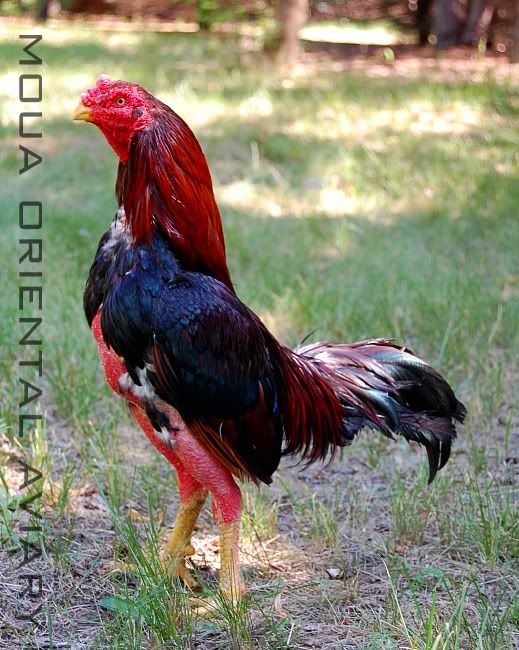
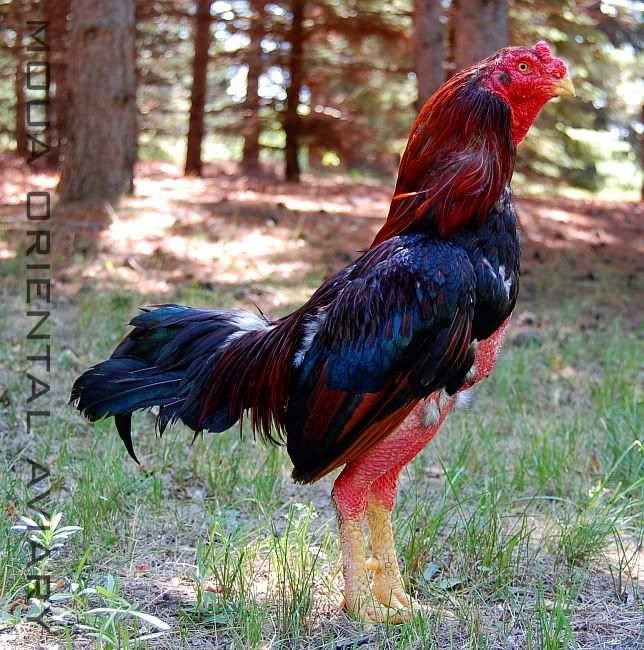
This 2007 Golden cock will also be a breeder for the 2009 season.

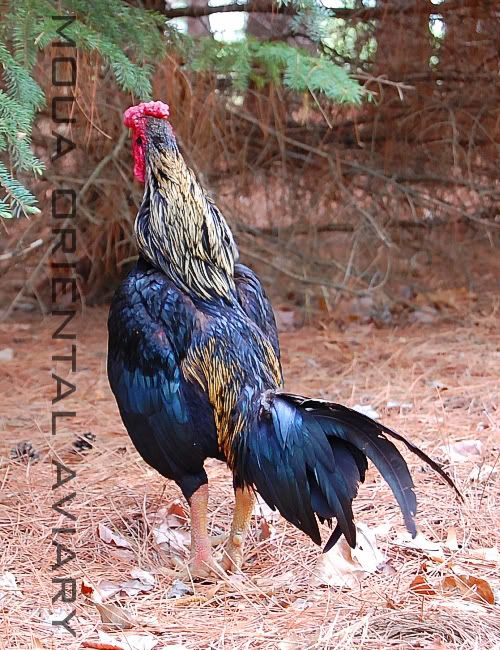
He has the typical excessive skin of the Rajah type Asil and also the three row of scales on each shank.
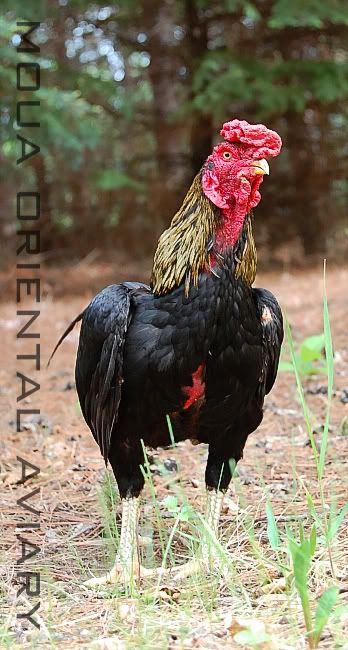
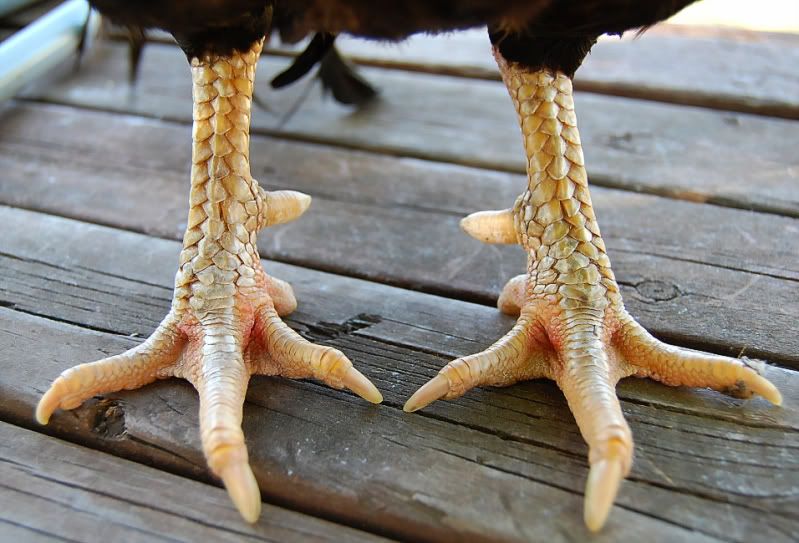
This is a 2007 Red Rajah Murgh Asil Hen from Javier Rosario of P.R.
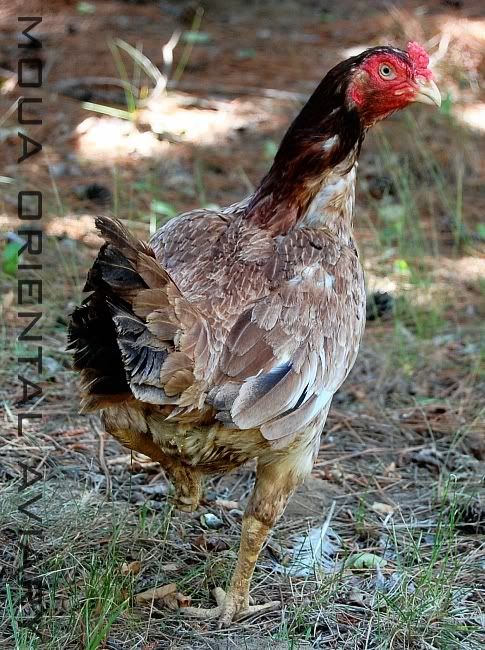
Rajah Murgh (Reza) Asil
ternational Asil Association (IAA)The International Asil Association (IAA)
The Asil is found on the Indian sub-continent and as mentioned earlier is probably the world oldest gamefowl breed. The oldest evidence of organized cockfighting is based on archeological finds which have been found in the Indus valley (today Pakistan but Indian territory till 1947). Understanding the Asil is not that easy. The breed is domestic to the Indian subcontinent. At present day this landmass consists of the following countries India, Pakistan, Bangladesh and Sri Lanka. This huge landmass is home to an enormous variety of ethnic groups and cultures. Tracing back local names of varieties or expressions is a pure hell as India alone has 21 national languages and over 200 registered dialects. Sometimes information from the homeland is controversial. Therfor analysis and comparison of this information is a delicate matter. Asil enthusiasts from all over the world provide valuable information. The International Asil Association (IAA) tries to provide genuine information enabling all Asil fanciers around the world to preserve the Asil breed along the proper conservation and breeding criteria.
The Reza is a small Asil with a weight not exceeding a weight of about 3 Kg (6.6 Lbs). This group of Asil reached worldwide popularity due to books and articles written by the English gamefowl expert Herbert Atkinson, Siran and Paul Deraniyagala from Sri Lanka and Carlos Finsterbusch from Chile. The Reza Asil family according the old (Western) gamefowl literature is subdivided into following strains: (Amir) Ghan, Sonatol, (Siyah) Rampur, Kalkatiya (Kaptan) and Jawa. All these strains are indentified by their specific color (!) In chronological order: blackreds, lightreds, black, speckled reds and silver duckwings. In the old days (colonial times) other colors such as whites, spangles, etcetra were regarded as -inferior-. According Herbert Atkinson purebred Asil should not exceed the weight of 3 Kg (6.6 Lbs). At present day the "classic" strains and names given mentioned by Atkinson are more or less forgotten. Anyone with a bit of breeding expirience will understand that after many decades the vitality of a bloodline slowly will be prone to degeneration. Remark: the native people in India, Pakistan, Bangladesh and Sri Lanka only know the Reza-type Asil by their local names (see Names paragraph).
__________________________________________________________________________________
This 2007 cock is out of stock in Puerto Rico were the competitive games are legally held . The breeder is Javier Rosario and they were brought into P.R. by Dr. Nelson Moreno. The history of these magnificent fowl are as follow:
"These birds originally were brought out of the Port of Calcutta, India and into Argentina, from there to Puerto Rico."
This red cock will be our main Reza Asil breeder for the 2009 season.


This 2007 Golden cock will also be a breeder for the 2009 season.


He has the typical excessive skin of the Rajah type Asil and also the three row of scales on each shank.


This is a 2007 Red Rajah Murgh Asil Hen from Javier Rosario of P.R.

©Moua Oriental Aviary 2008
Reza Asil
Reza Asil

More commonly (but incorrect) known as the "Rajah Murgh" Asil. This type of Asil has a weight of maximum 3 Kg (6 Lbs). Much seen on exhibitions in various colours. This Asil is also available as bantam variety (standarized in Europe). Note: in the UK known as "Atkinson Asil".

Reza Asil Information
Reza Asil
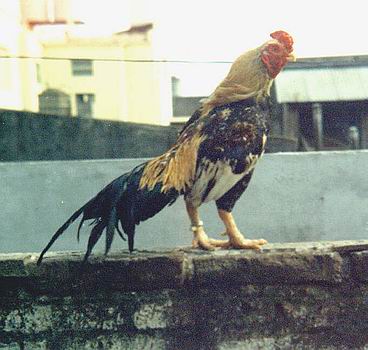
Foto links Züchter Bruno Aimone (Argentinien)
Foto rechts Züchter Johannes Metzler (Spanien)
Die Reza Asil sind eine Gruppe von Asil mit ein maximal Gewicht von 3 Kg. Diese Gruppe besteht aus 5 verschiedene Schläge: (Amir) Ghan, (Siyah) Rampur, Sonatol, Kalkatiya (Kaptan), Jawa Diese 5 Schlägen sind früher im Heimatland Indien (Pakistan und Bangladesh inklusive) als einzige Mitglieder der Reza-gruppe eingestuft worden als -Edel- . Diese -edele- Asil Schläge sind waren Wir die alte Quellen glauben dürfen nur in Händen von Radja (Prinzen) und Maharadja (Könige). Jeder Schlag wird gekennzeichnet durch ein typischer Farbschlag (wichtig !). Kopf: klein, rund, Kammform: niederiger festaufsitzender Erbsenkamm, Gesicht: trocken, Jochbein und Augenbrauen gut ausgebildet, Augenfarbe: Perlauge, Schnabelform: Raubvogel-artig, Stand: mittelhoch, Körper breit und kompakt, die Schulter breit aber angeschlossen getragen an den Körper, Brust: breit, Rückenlinie abfallend, Hals mittellang hinter dem Kopf eine Einsenkung oft "Hengstnacken" genannt, Schwanzlage: horizontal bsw leicht abfallend, Beinfarbe: Gelb, Weiss und Dunkel. Für eine spezifische Beschreibung der Farbschläge wird geraten unser SAK Bericht Asil zu studieren (mit Fotos). Bemerkung: alle andere kleine Asil wie Rotbunt, Blau, Grau, Gelb, Weiss, usw sind nach Quellen aus alte Kampfhuhnliteratur als -minderwertig- eingestuft worden.
Tuesday, April 5, 2011
Asil Breed
The Asil or Aseel is a breed of chicken originating from South Punjab/ Sindh area of Pakistan and India. Similar fowl are found throughout Southeast Asia and have names like Shamo, Taiwan, etc.
Similar to Asils are Sadal (called Malay in Europe). This is a very large breed of chicken from Pakistan and India. They have longer legs with thin thighs and little wattles with pea-combs. The difference between the two is that Sadal are not game (do not fight), and Asil do.
Asils were first used for cock fighting. Aseel is noted for its pugnacity. The chicks often fight when they are just a few weeks old and mature roosters will fight to the death. Hens can also be very aggressive towards each other.
Towards humans Asil are generally very tame and trusting. There are anecdotes where they have come to their keepers for other things than food, for example to get the keeper to open the door to the coop so they can get to roost.[1]
The hens are not good layers, but are excellent sitters. Laying depends on the Asil variety, the small Asil are known to be very poor layers, sometimes laying just 6 eggs a year, whereas larger Asil can lay around 40 eggs a year.
In the U.S., the breed is listed as Critical by the American Livestock Breeds Conservancy. Aseel breed is found in almost all states of India, but abundant in Andhra Pradesh.
Breed Standard
The Asil has a distinctive upright stance, drooping tail, and well-defined musculature.asils are good fighters The color ranges from white to black with black breasted red being the most common.
Asil head
The ideal Asil head is more or less round-shaped and broad, the eyes pearl white and protected by protuberant eyebrows and cheekbones, a small low set pea or walnut comb (except the single-combed Bihangham variety) with a relative short and thick beak. The color of the face is generally red. Asil with a dark-colored face are seen on South Indian Asil. Wattles should be absent. Only rudimentary presence is allowed.
Asil comb types
Asil show a variation in comb types and beak shapes. In generally we can say that North Indian Asil types such as the Reza Asil have (triple) pea combs only. The South Indian varieties such as the Malay and the Madras Asil show (triple) pea combs as well as walnut combs. Comb colour is red. Some varieties such as the Bihangham carry a single comb due to a throw back to the red jungle fowl, however these type of Asil are uncommon even in their homeland.
Wattles
Wattles should be small to absent, absent is preferred.
Asil beak types
The smaller the comb the better on Asil. North Indian type Asil have (triple) pea combs and a fairly large beak with the shape similar to an eagle. The birds from Southern India generally show a short but massive triangle shaped beak. Beak colour is ivory white. Reddish yellow colour is also acceptable.
Asil eyes
Original asils have blue colour eyes when young and may turn pearl-white when grown up. Red or orange-colored eyes are rear depending on the breed. Pale yellow-colored eyes can be seen in young birds which lighten with age into a pearl-white colour. Sometimes pearl-white colored eyes are seen showing tiny blood veins running in the eyes, so called "bloodshot" eyes. In some areas these are regarded as a sign of vitality.
Asil legs
Leg colour is ivory white. Black legs are acceptable for black colour Asils. The other main leg colors within the Asil breed are pale,grey and white,black, though they are considered inferior. The dark-colored leg colors are generally seen on the South Indian Asil. Some Asil show very rough scales pointing a little bit outwards. one the ways you recognise a asil(aseel) is by the legs if they are yellow it means there not pure aseel. what they could be is a shamo,taiwaan or other game birds.
Asil body description
The Asil should have broad shoulders and wings are carried against the body. The body of an Asil is very muscular but also compact.
Varieties
There are many varieties of Asil, some are standardized for shows such as the Reza Asil in the UK, some are simply named after the area where they are bred such as the Mianwali Asil from Pakistan or the colour, red/wheaten Asil are generally known as "Sonatol".
There are also hen-feathered Asil knows as "Madaroo" these are found in various colours, but the cocks come with feathers in hen colour, don't have sickle feathers in the tails and miss the large hanging feathers on the saddle. This variety is very rare.
Asil with feather beards under their beaks known as "muffed" and with tufts on the top of their heads known as "tasseled" are also seen, but are very rare especially outside India/Pakistan.
Bhaingam Asil variety have a have a large single comb but confirm to all the other Asil standards.
Broadly speaking, Asil in Europe are categorized and shown under these three types:
Madras asil madras asils a very big and muscular. They can get up to 32 inches the main colours are black,red,grey,blue and green.
Reza Asil
Height: Up to 50 cms tall. Weight: Maximum weight for the hens is 1.8 kg, max weight for the cocks is 2.7 kg.
This type is standardized by the Asian Hardfeather Society in the UK and is seen at shows throughout the UK, but is quite rare.
This group of Asil reached worldwide popularity due to books and articles written by gamefowl experts such as Herbert Atkinson, Siran and Paul Deraniyagala from Sri Lanka and Carlos Finsterbusch from Chile. The Reza Asil family according the old (Western) gamefowl literature is subdivided into following strains: (Amir) Ghan (Dark-Red), Sonatol(Light-Red), (Siyah) Rampur(Black), Kalkatiya (Kaptan)(Speckled-Reds) and Jawa(Duckwing). All these strains are identified by their specific color, these colors do not necessarily correspond with the area where the birds come from.
In colonial times other colors such as whites, spangles, golden etc. were regarded as inferior. At present day the "classic" strains and names given mentioned by Atkinson are more or less forgotten. The native people in India, Pakistan, Bangladesh and Sri Lanka only know the Reza-type Asil by their local names.
Kulang Asil
Height: Up to 75 cms tall. Weight: 5 to 7 kg.
The large Asil are divided into sub-varieties : North Indian, South Indian and Madras type. The North and South Indian varieties don't differ much. Only type of comb, shape of the beak and body shape are different. For example : Northern type = slender, Southern type = heavier build. The Madras Asil however is significantly different. They have a lower station, are heavier build and stronger boned. These birds often come in a bluish colour. This variety is found in the deep south of India, the Tamil Nadu state.
Sindhi breed
It is one of the tallest and biggest breed of Asils. Main colours are red and blue. They are mostly fought in the Sindh area of Pakistan. These aseels have good endurance and usually their fights last longer than Mianwali Aseels. With the arrival of Mianwali they have started to disappear from the fights.
Mianwali breed
This breed is mainly found in Mianwali district of Pakistan. However since its arrival, this breed has risen to popularity in Pakistan, currently the primary game breed used in the pits also preferred by gamblers. It is smaller compared to Sindhi aseels weighing between 1.5 to 3.5 kg depending on the preference of breeders. It is much faster and a better head hitter usually comes in small to medium height. A good Mianwali aseel should kill its opponent with in few minutes. They have been known to kill bigger roosters because of their speed and accuracy. They come in various colors such as Java(duckwing), Lakha (reddish), black and various others depending on the combination used in breeding. Very hard and a brave fighter with attitude to inspire, excellent in naked heels and metal spurs. There are many sub breeds of this breed owing to the combination used in breeding. A good tested Mianwali rooster would usually have offspring of a similar quality. Typical description would be small curved beak, strong joints, pearl/white/yellow eye color, short crow, small comb and do not have heavy body structure. May look smaller than other breeds but is excellent spurer.
Amroha
This is a rare breed of Aseel used in Pakistan and India. Very few of these roosters exist in their pure form. They are known to be small to medium like Mianwali. It is also known that they are champion of naked heel fighting. In simple, it is a fantasy of most aseel breeders in Pakistan.
Bantam Asil
Weight: Up to 0.75 kg.
Bantam Asil have been created at the end of the 19th century by an English breeder named William Flamank Entwisle. The breed got very popular after its creation but after a couple of decades interest in this variety slowly died out. Until the beginning of the 1980s nothing was heard about these little Asil. A Belgian breeder named Willy Coppens created them again using Shamo (chicken), Indian Game and Reza Asil. The breed was also introduced again in Holland and United Kingdom. At present day Bantam Asil are quite popular and they are bred in various colors.
[edit]
American Asil

History
The Asil or Aseel is a very ancient bird and was bred in India over two thousand years ago as a fighting bird. The name Asil is Arabic and means of long pedigree. They were brought to Europe around 1750. They are natural fighting birds with strong muscles and heavy bones and they have great stamina and courage. They have a distinctly powerful upright stance and the skin is yellow or white with a small pea comb and no wattles. Their eyes are pearly white and they have a heavy brow which is reminiscent of a hawk. They are hard feathered and the breastbone is bare while their beaks are strong and yellow. There is also a ¼ size bantam which are exact miniatures of the large fowl.
Behaviour
The females do not lay very well at all but make wonderful mothers as they are apt to become broody and make excellent sitters and protective mothers. The chicks are slow to mature and will often fight with each other from a very early age. These need to be broken up quickly as they will fight to the death if given the chance. Asils need plenty of space to allow escape during disputes. Despite being fighting birds, they can be tamed very easily and will eat from your hand quite happily. They prefer dry conditions and do not do well in a cold climate. They are not particularly flighty despite their strength. They are rare birds now and totally pure Asils are hard to find. Males weigh in around 4-6lbs while the females are 3-5lbs.
Varieties
There are no specific colours for the Asil although there are white, partridge mottled, wheaten, fawn, black white mottled, dark red, red wheaten, grey, spangled, duckwing, pile and silver necked blue varieties.
Status
Rare Asil Chickens for sale
There are no breeds of this type currently available for sale
Latest Breed Reviews
3.5 Out of 5 Stars Great for pets, shows - 18 May 2009
Asil are bad layers no question about it as most hens lay just enough eggs for reproduction. And they like to demolish your plants too.
However they are naturally tame and intelligent as they were originally a game breed, and therefore were bred to be handled by trainers. If you are looking for a pet breed that is tame and intelligent or want to show birds, these are a great choice.
They don't eat a great deal of food as cocks as max 6 lbs.
Remember that the cocks fight, so a cock and 2 hens is best to keep. Generally they are OK with other chicks but it depends on the line so always ask the owner, as some lines you can only keep one cock and one hen together!
Summary: Great for pets, shows and people that want fowl with a long history
However they are naturally tame and intelligent as they were originally a game breed, and therefore were bred to be handled by trainers. If you are looking for a pet breed that is tame and intelligent or want to show birds, these are a great choice.
They don't eat a great deal of food as cocks as max 6 lbs.
Remember that the cocks fight, so a cock and 2 hens is best to keep. Generally they are OK with other chicks but it depends on the line so always ask the owner, as some lines you can only keep one cock and one hen together!
Summary: Great for pets, shows and people that want fowl with a long history
Subscribe to: Posts (Atom)


No comments:
Post a Comment